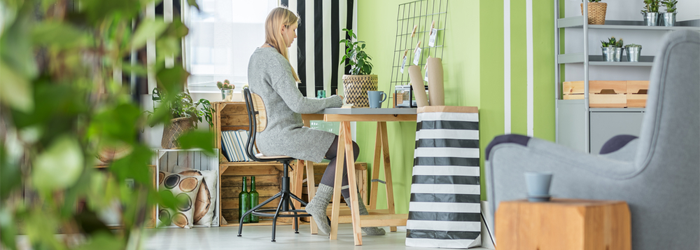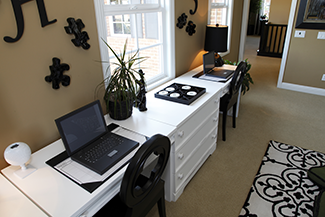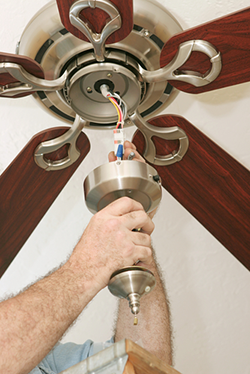Creating Multi Use Spaces At Home for School & Work
 28 July 2020
28 July 2020 

Creating Purposeful Space for Working and Schooling At Home
Working from home is nothing new. As a matter of fact, in January of this year Scottsdale, Arizona was ranked the #1 city in the nation to work from home by the business publication, SmartAsset. Gilbert, Chandler and Mesa also made the list for best places to work from home. Of course, COVID-19 has forced more people than ever to set up some sort of temporary or long term workstation at home.
In March, when the first stay-at-home order was issued, most of us probably thought life would be back to normal in six weeks' time. However, here we are five months into the shut down and there is still a lot of uncertainty about when we will return to normal. Most schools are reopening with only an online option and many workplaces still prefer to have their employees work from home.
Working and schooling from home can be challenging as families work to find individual space and privacy and still have the normal functions of the home.
How To Make This At Home Arrangement Work?
It can be a real challenge to create spaces in your home where you can multitask with schooling and work. Bridges Connor of Get Organized with Bridges + CO says, "to create intentional living spaces during this 'COVID clutter' time I believe it is important to live with less. I truly believe less is more. More time to yourself, more money in your pocket, more happiness, & less stress!"

Living with less begins with getting organized. Bridges offers four simple steps to organize any space in your home. Begin by sorting everything into four piles and label them:
- Keep
- Donate
- Recycle
- Trash
First, purge everything into the donate, recycle or trash piles/boxes. Next, create a place for everything in the keep pile!
- Consider where and how often you use an item.
- Use the most convenient spots for the most often used items. Then go vertical, using harder to reach spaces for less used items.
Once you have purged and organized you will have more choices for creating clutter free workspaces.
It is possible to create spaces with minimal investment.
- To use the space you have, for the many purposes it needs to fulfill, you will most likely be using one room for two purposes. If you don't need complete privacy for phone calls, the dining room table could work well. If you need to be able to place a call or take a class, a corner of the guest room could work.
- Access what equipment you will be using. If you have a laptop you will need less room than you would with a desktop. Will you need a place for a printer and files? Credenzas, hutches or armoires designed for computers with doors that close are a great option. At the end of the workday you can close up your workspace and not be pulled into the trap of working around the clock.
- For smaller workstations a wall hanging desk works great. They don't take up as much room as a full desk. It would be possible hang a couple of desks in one room for your homeschool students and still have space left in the rest of the room.
 Creating a place for books and reference material can be solved with a shelving unit that fits over the desk area or floating shelves. Portable crates that can be stored out of sight when not in use are great for storing and organizing paperwork. A storage bench near the desk would allow for an extra place to sit as well as hold books or papers.
Creating a place for books and reference material can be solved with a shelving unit that fits over the desk area or floating shelves. Portable crates that can be stored out of sight when not in use are great for storing and organizing paperwork. A storage bench near the desk would allow for an extra place to sit as well as hold books or papers.- "Lighting is so important", says Mary Knott of Mary Fisher Designs. When setting up your workstation consider the light source. Watch the light throughout the day taking note of the lighting during times you plan to work there. Knott says, "if your back is to the light it will create shadows on your work. Light needs to come from the front."
- If you find that you have cords everywhere, you can buy special devices or cord organizers to organize them. If you haven't switched to Wi-fi for your computer and printer, now might be the time to make the switch and do away with some of your tangled piles of cords altogether.
You could also hire an electrician for a couple of hours. He can make several upgrades that will make a big difference in the quality of your home office or school.
Electrical Improvements Include:
- Install outlets convenient to areas where you will be setting up. Before the electrician pays a visit, estimate how many outlets you'll need. Every outlet has to be on a stud and you want them on "open" walls, not covered up by desks and cabinets, although you can have them installed inside cabinets.
- Install a whole house surge protector on your electric panel so that you keep all electronic equipment safe in case of power outages or electrical storms.
- Add fans in rooms to keep air moving and the occupants more comfortable
If you take the time to organize your work and study spaces, you may just grow to like the changes of working and schooling at home.
###
Photo Credits:
- Shutterstock
related content
- DIY Q&A: Finding New Homes for Clutter
- DIY Q&A: Make Better Use of Your Home Office
- DIY Q&A: Will Running Ceiling Fans All Day In Every Room Keep My Home Cooler?
- DIY Q&A: Protecting Your Electronics and Appliances from Power Surges
- DIY Q&A: How To Choose A Contractor
- DIY Q&A: Do Building Codes Apply to Old Houses?
- Podcast: Make This Weekend A DIY Weekend At Your House
Print this page
recent post
- Duck, Duck, Duct! How Often Should Ductwork Be Cleaned?
- Vinyl vs. Fiberglass Windows: Which Is The Better Choice Of Replacement Window?
- We May Be The Grand Canyon State, But The Rocky Mountains Are Important For Arizona
- Welcome to Arizona! Things A Newbie to Arizona Should Know
- The Pros & Cons of Buying A Flipped House
- Getting In On The Ground Floor
- Why It’s More Critical Than Ever To Get Your AC Serviced Before Summer
- The Reality of Remodeling
- What To Look For When Comparing Your Roofing Quotes
- What To Expect When Buying New Windows & Doors
